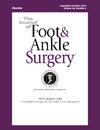Outcomes in Patients With Heel Ulcerations that Underwent Below the Knee Amputations Versus Vertical Contour Calcanectomy: Importance of Selection Criteria
IF 1.3
4区 医学
Q2 Medicine
引用次数: 0
Abstract
The aim of the study was to compare preoperative factors and postoperative outcomes in patients with heel ulcerations that primarily had a transtibial (below the knee) amputation (N = 38) versus vertical contour calcanectomy (n = 62). The groups had no statistical difference between their Charlson Comorbidity Index Score, a prognostic score of 10-year survival in patients with multiple comorbidities. The odds of primary closure were 21.1 times higher in patients that underwent below knee amputation compared to patients that underwent vertical contour calcanectomy (OR 21.1 [95% CI 3.89-114.21]). The odds of positive soft tissue culture at time of closure were 17.1 times higher for patients that underwent vertical contour calcanectomy (OR 17.1 [95% CI 5.40-54.16]). The odds of a patent posterior tibial artery were 3.3 times higher for patients that underwent vertical contour calcanectomy (OR 3.3 [95% 1.09-10.09]). The secondary aim of the study was to evaluate preoperative factors and postoperative outcomes in patients with failed vertical contour calcanectomy, defined as needing a below knee amputation. The odds of vertical contour calcanectomy failure was 13.7 times higher in male patients (OR 13.7 [95% CI 1.80-107.60]). Vertical contour calcanectomy failure was 5.7 times higher in patients with renal disease (OR 5.7 [95% CI 1.10-30.30]), and vertical contour calcanectomy failure was 16.1 times higher for patients who needed additional surgery post closure (OR 16.1 [95% CI 1.40-183.20]).
接受膝下截肢术与垂直轮廓钙化切除术的足跟溃疡患者的疗效:选择标准的重要性。
该研究旨在比较主要采用经胫(膝下)截肢术(38例)和垂直轮廓方形切除术(62例)的足跟溃疡患者的术前因素和术后效果。两组患者的夏尔森合并症指数评分(Charlson Comorbidity Index Score)之间没有统计学差异,而夏尔森合并症指数评分是有多种合并症的患者十年生存率的预后评分。与接受垂直轮廓钙化切除术的患者相比,接受膝下截肢术的患者初次闭合的几率要高出21.1倍[OR 21.1 (95% CI 3.89-114.21)]。接受垂直轮廓方形截骨术的患者在截骨时软组织培养呈阳性的几率是接受垂直轮廓方形截骨术患者的 17.1 倍[OR 17.1 (95% CI 5.40-54.16)]。接受垂直轮廓钙化切除术的患者出现胫后动脉通畅的几率是接受垂直轮廓钙化切除术患者的 3.3 倍[OR 3.3 (95% 1.09-10.09)]。研究的次要目的是评估垂直轮廓方形截骨术失败患者的术前因素和术后结果,垂直轮廓方形截骨术失败的定义是需要进行膝下截肢。男性患者垂直轮廓方形切除术失败的几率是男性的13.7倍[OR 13.7 (95% CI 1.80-107.60)]。患有肾病的患者垂直轮廓方形切除术失败的几率是普通患者的5.7倍[OR 5.7 (95% CI 1.10-30.30)],关闭手术后需要再次手术的患者垂直轮廓方形切除术失败的几率是普通患者的16.1倍[OR 16.1 (95% CI 1.40-183.20)]。
本文章由计算机程序翻译,如有差异,请以英文原文为准。
求助全文
约1分钟内获得全文
求助全文
来源期刊

Journal of Foot & Ankle Surgery
ORTHOPEDICS-SURGERY
CiteScore
2.30
自引率
7.70%
发文量
234
审稿时长
29.8 weeks
期刊介绍:
The Journal of Foot & Ankle Surgery is the leading source for original, clinically-focused articles on the surgical and medical management of the foot and ankle. Each bi-monthly, peer-reviewed issue addresses relevant topics to the profession, such as: adult reconstruction of the forefoot; adult reconstruction of the hindfoot and ankle; diabetes; medicine/rheumatology; pediatrics; research; sports medicine; trauma; and tumors.
 求助内容:
求助内容: 应助结果提醒方式:
应助结果提醒方式:


